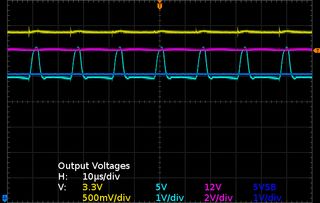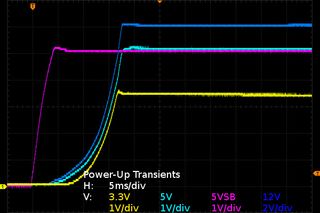Antec Aria AR300 PSU Repair
Have you ever bought a computer case with a proprietary PSU form factor? What do you do when it eventually wears out? One option is to repair it.
Do We Have A Fix?
Time to roll the drums, take a deep breath, plug it in, start the camera, duck (just in case) and throw the switch...

It's ALIVE!
Now that the unit is back from the dead, it is time to assess its remaining issues. As mentioned in the interlude, three of the five output filter caps I could easily pull out for measurement were in poor shape and definitively required replacement, two of them from the 5V rail. Predictably enough, with the 5V rail having the two worst capacitors of the main output lot, the effect on output quality is obvious here with periodic pulsing to 6V.
I do not have 10V 2200µF or better fresh capacitors that fit under the heat sink due to circuit board components, including other capacitors, being packed too tightly around the capacitor footprints to accommodate replacements any wider than the original 10mm diameter. However, I do have a HiPro power supply from an IBM ThinkCenter PC that had a catastrophic primary-side failure and was packed with 10mm 10V 2200µF Teapo SC capacitors for the 5V, 5VSB and 3.3V rails which seemed like perfect replacement candidates – definitively nice upgrades for the original Fuhjyyu TNR and Teapo SEK assuming the Teapo SC are still good. Since the donor power supply presumably had a quick demise rather than a slow capacitor decay one, I am fairly confident its secondary caps will be in reasonably good shape. And sure enough, they all tested well within tolerances for capacitance and were indistinguishable from the Panasonic FM on my ESR check. Reasonably convinced that my salvaged caps would perform substantially better than the dead or dying caps they are replacing, I decided to put the SCs in.
I could not find a direct replacement for the 10mm 4700µF Fuhjyyu TMR, so I just slapped one more 2200µF SC in its place. At a glance, it seems 2200µF is the largest capacitance most manufacturers offer in 10mm diameter low ESR format with 10 to 16 volts rating.
My donor power supply did not have 8mm caps for the 5VSB output either, so I had to leave my 10mm 1200µF FMs flapping in the breeze until I order 8mm parts for that. Conveniently enough, the Rubycon 1000µF 10V ZLH I planned to order for the SL300 will fit nicely here too.

After letting my repaired unit simmer overnight to see if the 10Ω resistor would survive with the main outputs enabled and powering a 20W 12V halogen desk lamp, I went back to have a look at power-up transients. Everything looked fine. The 5VSB output overshot by 200mV while the main outputs only overshot by about 100mV, well within ATX's 10% power-up transient tolerances. The main outputs rise from 0% to 100% in 15ms, which also meets ATX's 20ms maximum requirement.
Stay on the Cutting Edge
Join the experts who read Tom's Hardware for the inside track on enthusiast PC tech news — and have for over 25 years. We'll send breaking news and in-depth reviews of CPUs, GPUs, AI, maker hardware and more straight to your inbox.
Once these measurements were done, I disconnected the power supply, opened it again and felt around for anything unexpectedly warm. The first thing I checked was ZD4 and components immediately around it. I also took a look at my new R29. Its markings were still white, a sign that if it did heat up, it did not get hot enough to discolor the ink. It seems ZD4 is clearly not meant to dissipate any significant amount of power when good capacitors are present and provide the bulk of flyback clamping for the standby/auxiliary transformer's outputs.
What are those zeners for? They are primarily intended for clamping leakage inductance. While the bulk of flyback energy in the 5VSB/auxiliary transformer ends up on the 5VSB output, a small amount of it will still get dumped on other windings due to leakage inductance. Since the auxiliary windings may have negligible load attached to them, the stray inductance energy can cause auxiliary capacitors to slowly creep up to arbitrarily high voltages. The zeners simply put a ceiling on how high this is allowed to go.
Current page: Do We Have A Fix?
Prev Page Where To Go From Now Next Page Revisiting The Photocoupler-
iam2thecrowe That was a good read. I have a lot of custom power supplies (not PC atx) that i would like to fix at work instead of replace, would be a lot cheaper (there's some high wattage power supplies that cost $5000 to replace). Need to convince the boss to buy a good oscilloscope.Reply -
Rookie_MIB I have several of those cases - they make nice little machines for office use but the PSUs tend to flake. I've had to replace several...Reply -
Daniel Sauvageau All the standby power supplies I remember looking at are of the good old flyback design and one particularity of the flyback topology is that it has the worst ripple current on the output capacitors of all converter topologies or in other words: it is the harshest on output capacitors. Until I saw the waveforms while poking around the SL300, one little yet important detail skipped my mind: the harsh current waveform behavior applies to ALL outputs.Reply
Any flyback supply with sub-par output capacitors on any of its outputs will inevitably fail in relatively short order.
After that 'oops' moment, I decided to pop the lid on my LG 204WT which I thought had dying CCFL tubes, popped three of its auxiliary supply capacitors off the board, measured them at 5-20 ohms of ESR, replaced them, no more flicker or random turn-on issues. -
gnyff I love it when stuff is repaired! It's so sad that almost every consumer device today is made to fail and be replaced. Even in the cases where the designer did not specifically design for failure most commonly it's definitely not cost-effective for the user to have it repaired. :-(Reply
Anyways, I've also replaced one of those lousy non-standard PSU. Hard to find and depressingly expensive. Thus, I am avoiding non-standard parts as much as possible now! ;-)
By the way, in one of my systems the standby power was around 12W (!) even after shutting off 5VSB functions (wake on LAN, keyboard etc) in the BIOS. I did on bother to investigate further (thinking "lousy supply"!) and simply added a proper "full off" power switch. Probably other owners should think of doing the same ;-) -
Rookie_MIB Reply16509494 said:Anyways, I've also replaced one of those lousy non-standard PSU. Hard to find and depressingly expensive. Thus, I am avoiding non-standard parts as much as possible now! ;-)
By the way, in one of my systems the standby power was around 12W (!) even after shutting off 5VSB functions (wake on LAN, keyboard etc) in the BIOS. I did on bother to investigate further (thinking "lousy supply"!) and simply added a proper "full off" power switch. Probably other owners should think of doing the same ;-)
I wonder if a SFX PSU could be mounted in those cases. Might be a viable solution... -
nukemaster Another great one!Reply
I actually was interested in that case back when it was released, but just kept rocking the Sonata and Sonata II. While my power supplies did not fail. caps leaked after a while(power supplies still worked)and I took the power supplies out of service forever.
Rookie_MIB,
SFX would be an interesting idea to see for sure. My SFX is still going after 5 years of 24/7 operation(not bad for a case included 300 watt unit). -
Daniel Sauvageau Reply
The dimensions might fit but mounting holes would be on the wrong side (for mounting in a way that might fit internally) and the IEC socket would face either the motherboard or the top cover. Nothing some drill-and-tapping with some wire splicing cannot fix for people who would favor this route instead of a repair of the existing unit where that is possible.16509868 said:I wonder if a SFX PSU could be mounted in those cases. Might be a viable solution...
BTW, the total repair cost for the 5VSB side is about $1.50 for the caps and resistor. The rest is basically free since I scavenged the SCs from a dead (catastrophic primary-side failure) PSU and would have cost around $2.50 otherwise. If Asus had specified higher quality parts from Channel Well though, the PSU may have cost less than $0.50 extra to get right on the first try. Evem doing as little as specifying Teapo SC as the minimum requirement would have easily doubled the trouble-free service life over using SEK..
It always bugs me when only a few pennies worth in parts and materials can spell the difference between a product that might only last 2-3 years and a product that should easily last 10+ years. -
nukemaster That small cost per unit adds up.Reply
I can not count the number of times I say, gee a xx cent part would have solved this damn issue and yet no one does it.
Drilling and making it fit is no issue. :)
I still get my small system fix with an SG05 case.
Where do you get your parts from? Digikey is not too expensive, but many times the shipping cost more than the parts(especially with resistors that are cheap to begin with.). -
Daniel Sauvageau Reply
The "small cost" may add up but if you charge $1 to put the $0.50 worth of better quality parts in, you still make a 100% profit on that extra cost and you score points in the quality/reliability column. For the most part, those better quality parts are the same physical size, so no fitting or PCB layout concerns there.16511613 said:That small cost per unit adds up.
Where do you get your parts from? Digikey is not too expensive, but many times the shipping cost more than the parts(especially with resistors that are cheap to begin with.).
As for where I get my parts, they are mostly Digikey. I either lump my order with parts I need to repair something for someone else (and pass the shipping cost to them) or build my order for multiple non-urgent projects until it qualifies for free shipping.
Edit: and for things like 0805 resistors and capacitors, I usually order in cut-tapes of 100 since we're still only talking $1-2 there. If I had more storage space, I would order whole reels for $10-15 (2000-3000 units) and likely never have to worry about ordering more of that resistor or capacitor value (for personal use) for the rest of my life. -
pjmelect I often repair computer power supplies and I enjoyed reading this article. One comment, that may help others and may explain some things in the article such as the power reduction of the fixed power supply.Reply
Capacitors with high ESR always have a very high leakage current near their rated voltage. The leakage current at low multi-meter voltage levels is not normally measurable, but increasing the voltage across the capacitor dramatically increases the leakage. Circuits with capacitors with high ESR in them normally fail not due to the ESR or the reduction of capacitance, but due to the high leakage current. If you do not have a ESR meter you can simply put a suspect capacitor across a power supply at its rated voltage and check the leakage current. A high leakage current is a good indication of a high ESR value.
I use a in-circuit ESR meter to test all of the electrolytic capacitors (even the small ones) before I even start trying to fault find a power supply.
Most Popular


